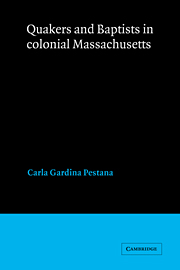7 - The politics of religious dissent
Published online by Cambridge University Press: 22 October 2009
Summary
After the efforts to rid the colony of sectarianism failed, orthodox leaders turned their attentions to containing the threat posed by the sects. The battle was no longer fought primarily by the colonial government – which was restrained by royal as well as some popular displeasure over the initial persecution – but was taken up instead by the colony's ministers. The latter were not only freer to act because of the unofficial nature of their role in imperial politics; they also felt particularly responsible for the souls of their parishioners and the fate of the New England way. As they shouldered responsibility for policing the boundaries between orthodoxy and sectarianism, ministers – led by John Higginson of Salem – unhappily acknowledged that the problem of dissent had more to do with popular attitudes than with state policy.
To a far greater degree than has been previously appreciated by historians, the Quakers and the Baptists actively shaped the changing orthodox response to their presence. Taking their cue from the sectaries themselves, leading clergymen developed two distinct strategies to shield their flocks. The first of these, which involved casting sectaries as aliens, followed from the Quakers' approach to the orthodox establishment. The Baptists provided the inspiration for the second tactic, which focused on educating the populace. The ministers' emphasis shifted over time, as they responded to changes in the broader political context and they reversed their position on which sect posed the major danger to orthodoxy.
- Type
- Chapter
- Information
- Quakers and Baptists in Colonial Massachusetts , pp. 145 - 164Publisher: Cambridge University PressPrint publication year: 1991



